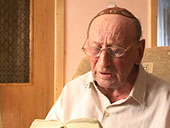
Moyshe Nayman 's parents owned cattle and worked the land during his childhood. He grew up with four siblings and helped out his parents on the farm. His father and grandfather made kosher wine for the community. After he finished his cheder education, he attended a yeshiva in Korsun and then studied with Rabbi Chaim Elazar Spira in Mukacheve. During World War II, he was a forced laborer for a Hungarian labor battalion, before his deportation to the Mauthausen-Gusen concentration camp. He was liberated from the Gunskirchen forced labor camp.
Other Interviews:
Sleeping At Grandpa'sChildhood On A Farm
Mauthausen
Klyachanovo, Ukraine
In this clips, Moyshe Nayman talks about his fate during World War II. In 1942, he was taken for forced labor digging dugouts for the Hungarian Second Army. He was then deported to the Mauthausen concentration camp in Austria. He briefly mentions an attempt to escape the camp, but ultimately he was relocated to the Gunskirchen camp. Nayman remembers the mass shootings of the camp, and the German dogs that terrorized the prisoners.
Over seventy percent of Transcarpathian Jewry was killed in Auschwitz. A minority of the prewar population of 102,000 individuals, however, spent the war years in hiding, under Hungarian or Russian forced labor.
Approximately, 40,000 predominately Jewish "recruits" as young as 16 were "drafted" from Transcarpathia and other occupied territory into Hungarian labor battalions to support the war effort between the years 1939 and 1944. The province was under fascist Hungarian occupation from 1938 until March 1944, when Germany seized Hungary.
